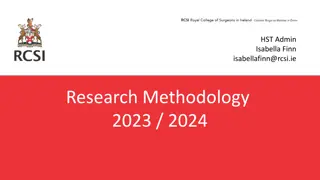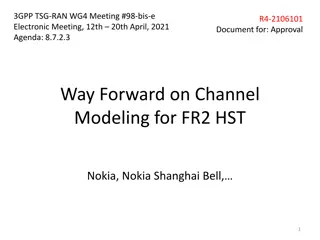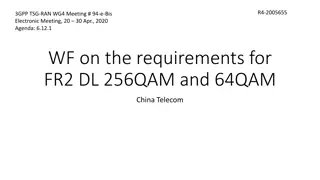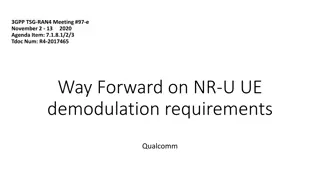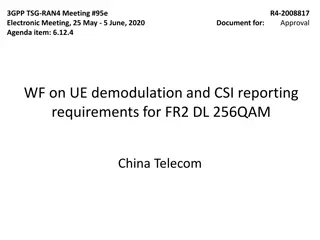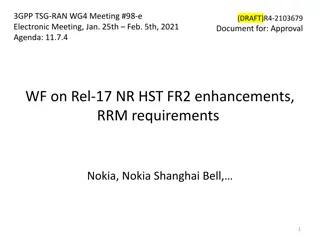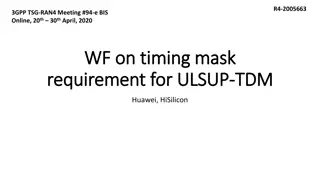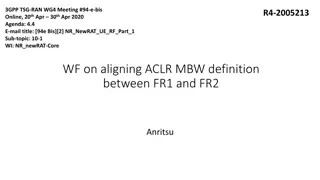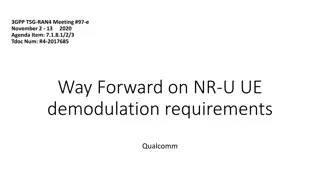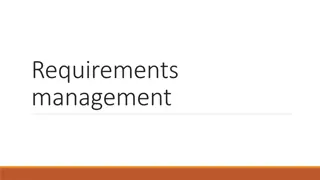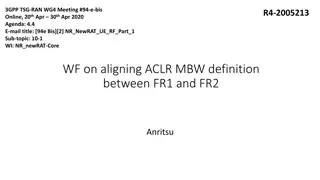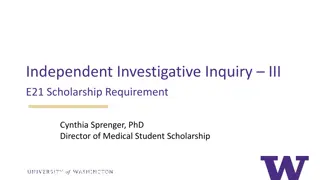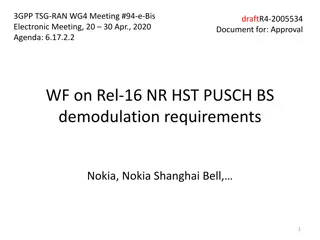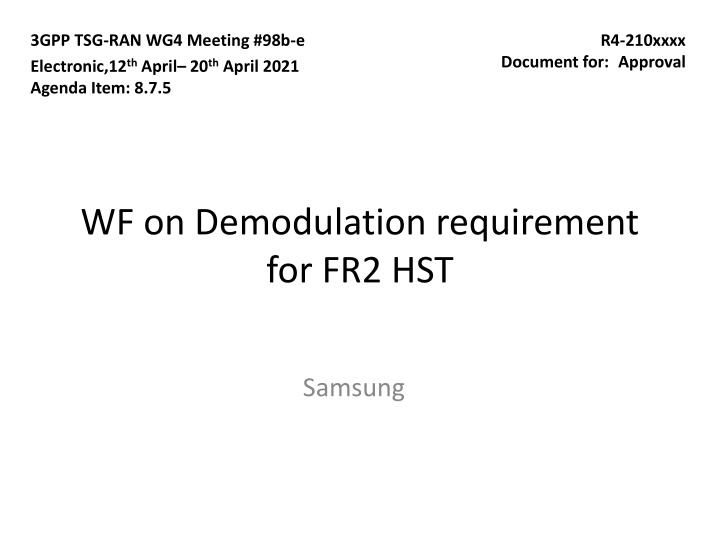
Demodulation Requirement for FR2 HST in Samsung 3GPP Meeting
This document discusses the approval workflow for demodulation requirements in Frequency Range 2 (FR2) High-Speed Train (HST) systems by Samsung at the 3GPP TSG-RAN-WG4 Meeting. It covers background information, agreed workflows in previous meetings, maximum speed feasibility studies for uplink and downlink configurations, as well as RS configurations for frequency offset tracking. Various options for DMRS and PTRS configurations are explored for both uplink and downlink, involving multiple vendors like Samsung, Ericsson, Nokia, and Huawei.
Download Presentation

Please find below an Image/Link to download the presentation.
The content on the website is provided AS IS for your information and personal use only. It may not be sold, licensed, or shared on other websites without obtaining consent from the author. If you encounter any issues during the download, it is possible that the publisher has removed the file from their server.
You are allowed to download the files provided on this website for personal or commercial use, subject to the condition that they are used lawfully. All files are the property of their respective owners.
The content on the website is provided AS IS for your information and personal use only. It may not be sold, licensed, or shared on other websites without obtaining consent from the author.
E N D
Presentation Transcript
3GPP TSG-RAN WG4 Meeting #98b-e Electronic,12th April 20th April 2021 Agenda Item: 8.7.5 R4-210xxxx Document for: Approval WF on Demodulation requirement for FR2 HST Samsung
Background Agreed WFs for FR2 HST WI in previous meetings R4-2017828, WF on NR support for HST in FR2 , Samsung. RAN4#97-e meeting R4-2103240, WF on Deployment Scenario and UE RF Requirement for FR2 HST , Samsung. RAN4#98-e meeting 2
Maximum Speed feasibility study and requested RS configuration for Uplink It is feasible to support maximum speed with 350km for uplink with PTRS or DMRS+PTRS configuration used for frequency offset tracking with 120KHz SCS Configure PTRS during the PUSCH demodulation test DMRS+PTRS configuration for PUSCH demodulation requirement with single-tap channel model Option 1: 1 DMRS +PTRS (L=1,K=2) (Samsung, Ericsson) Option 2: 1+1 DMRS +PTRS (L=1,K=2) (Nokia) Option 3: 1+1+1 DMRS+PTRS(L=1, K=2) (Huawei) 4
Maximum Speed feasibility study and requested RS configuration for Downlink It is feasible to support maximum speed with 350km/h for downlink with TRS (4 symbol interval)for frequency offset tracking under unidirectional RRH deployment with 120KHz SCS FFS on whether it is feasible to support maximum speed with 350km/h for downlink with TRS( 4 symbol interval) +SSB for frequency offset tracking under unidirectional and bi-directional RRH deployment with 120KHz SCS FFS on whether It is feasible to support maximum speed with 350km/h for downlink with TRS (4 symbol interval)+PTRS (L=1) for frequency offset tracking under unidirectional RRH deployment with 120KHz SCS FFS on whether it is feasible to support maximum speed with 350km/h for downlink with PTRS or DMRS(1+1+1)+PTRS(L=1,K=2) configuration used for frequency offset tracking under single tap propagation conditions with 120KHz SCS Configure PTRS during the PDSCH demodulation test RS as baseline for frequency offset tracking to support 350km/h Option 1: SSB+TRS (Huawei, Ericsson, Samsung, Qualcomm) Option 2: SSB+TRS+PTRS for bi-directional deployment (Intel) SSB+TRS for unidirectional deployment (Intel) DMRS configuration for PDSCH demodulation requirement Option 1: 1 DMRS (Ericsson) Option 2: 1+1+1 DMRS (Ericsson, Huawei) 5
Maximum Doppler Calculation Carrier frequency for Doppler frequency calculation 30GHz (Ericsson, Nokia, Intel, Samsung, Qualcomm) 6
UE demodulation requirements
Test Scope Test scope of DL requirements Only define PDSCH demodulation performance requirements in Rel-17 FR HST WI Requirement for scenario A or B Option 1: Define PDSCH demodulation performance requirements only with one deployment scenario (A or B) (Samsung, Intel, ) Option 2:Define PDSCH demodulation performance requirements with the worst cases of two scenarios (Ericsson, Nokia) Option 3:Define PDSCH demodulation performance requirements with both scenarios if needed (Huawei) Consider output of FR2 HST Deployment scenarios whether to cover scenario A and/or B Requirement for uni-and bi-directional RRH deployment scenarios FFS to define both PDSCH demodulation requirements for uni- and bi-directional RRH deployment scenarios FFS to define the test applicability rule if both PDSCH demodulation requirements for uni-and bi-directional RRH deployment scenarios are defined Consider output of FR2 HST Deployment scenarios whether to cover uni- and/or bi- directional RRH deployment 8
Test Scope Transmission schemes No PDSCH requirement with SFN joint transmission scheme in Rel-17 FR2 HST WI DPS transmission schemes DPS transmission scheme in Uni-directional RRH deployment scenario Option 1: scheme 1a; Option 2: scheme 1b; Option 3: both scheme 1a and scheme 1b DPS transmission scheme in bi-directional RRH deployment scenario Option 1: scheme 1a ; Option 2: scheme 1b; Option 3: both scheme 1a and scheme 1b FFS on PDSCH requirements of HST single tap 9
Test Setup SCS and BW Option 1: 120KHz with 100MHz (Samsung, Intel, Ericsson, Qualcomm) Option 2: 120KHz with 200MHz (Huawei) UE frequency error FFS on considering the impact of UE frequency error on DL demodulation performance 10
Basic simulation assumption Option 1 (Huawei) Parameter Value Maximum Doppler [9596Hz] Channel model [single-tap], [DPS] CBW/SCS [200MHz/120kHz] PDSCH mapping Type A, start symbol 1, duration 13 DMRS [1+1+1] PTRS KPTRS=2, LPTRS=1 Antenna configuration [2x2] MCS [17] Test metric 70% of maximum throughput Other options are not precluded 11
Testability issues for FR2 HST UE RAN4 to discuss on the impact of the assumption of a static UE and single probe OTA chambers on the FR2 high speed train demodulation test design Option 1: Assumption two probes in chamber, as RRM assumption with 2AOA tests Option 2: Assume static UE and single Probe. Combine RRM and Demod requirements as a single feature to support HST FR2 operation Option 3: Study an approach with taking into account continuous UE movement from RRH to RRH FFS keep into account the testability of high power devices inside OTA chambers, for the definition of radiated demodulation requirements for FR2 HST 13
BS demodulation requirements
Test Scope Test scope of UL requirements Only define the following BS demodulation performance requirements in Rel-17 FR HST WI PUSCH UL timing adjustment PRACH 15
Test Scope Requirement for scenario A or B Option 1: Define PUSCH demodulation requirements based on the worst case scenario Option 2: Define PUSCH demodulation requirements only with one deployment scenario (A or B) Option 3: Define PUSCH demodulation requirements for both two scenarios if needed Consider output of FR2 HST Deployment scenarios whether to cover scenario A and/or B 16
Test Scope Requirement for uni- and bi-directional RRH deployment scenarios FFS to define both PUSCH demodulation requirements for uni-and bi- directional RRH deployment scenarios FFS to define the test applicability rule if both PUSCH demodulation requirements for uni-and bi-directional RRH deployment scenarios are defined Consider output of FR2 HST Deployment scenarios whether to cover uni- and/or bi-directional RRH deployment 17
Test Setup for PUSCH requirements Waveform Only CP-OFDM SCS&BW Option 1: 120KHz SCS with 50MHz, 100MHz or 200MHz (Intel, Nokia) Option 2: 120KHz SCS with 100MHz (Samsung) Option 3: 120KHz SCS with 200MHz (Huawei) Antenna Configuration 1Tx2Rx Low Resource mapping type: type B Length of data symbol Option 1: 9 Option 2: 10 MCS Option 1: MCS16 Option 2: MCS16 and MCS17 Other options are not precluded 18
Test Setup for UL timing adjustment requirement Test Scenario Scenario Y Simulation Assumption for scenario Y Option 1(Huawei) Parameter Value Channel Model Stationary UE: AWGN, Moving UE: AWGN UE speed 350 km/h CP length Normal A 1.25 s 1.04 s-1 MCS 16 CBW 200MHz PUSCH resource allocation 0 to 65 RB for moving UE, 66 to 131 for stationary UE SRS resource allocation last symbol in slot #3 in radio frames, CSRS = 33, BSRS =0, for 132 RB Other options are not precluded 19
Test setup for PRACH PRACH format Option 1: only C2 (Samsung, Huawei, Intel, Ericsson) Channel AWGN Frequency offset Option 1: align the Doppler value with PUSCH Option 2: 9722Hz with 350km/h at 30GHz carrier frequency Test Preamble Configuration for Ncs Option 1: Ncs=0 Option 2: Ncs=69 Other options are not precluded 20
Contributions List in RAN4#98-e T-doc No. R4-2104681 R4-2105028 R4-2105029 R4-2105030 Title HST FR2 BS demodulation aspects Maximum Supported Speed from Demod perspective for FR2 HST View on UE demodulation requirement for Rel-17 FR2 HST View on BS demodulation requirement for Rel-17 FR2 HST Company Ericsson Samsung Samsung Samsung R4-2106435 Analysis on max supported speed for HST FR2 demodulation requirements Intel Corporation R4-2106436 R4-2106437 R4-2106473 R4-2106780 R4-2106829 R4-2106830 R4-2106831 R4-2106865 R4-2106866 R4-2106916 View on UE demodulation requirements for HST FR2 View on BS demodulation requirements for HST FR2 Preliminary observations on FR2 HST UE Demod Performance Test On FR2 HST BS demodulation requirements Discussion on general issues for NR FR2 HST demodulation requirements Discussion on UE demodulation requirements for FR2 HST Discussion on BS demodulation requirements for FR2 HST HST single tap channel profile for unidirectional deployment UE demodulation requirements for HST FR2 On HST FR2 Maximum Supported Speed from Demodulation Perspective Intel Corporation Intel Corporation Qualcomm Incorporated Nokia, Nokia Shanghai Bell Huawei, HiSilicon Huawei, HiSilicon Huawei, HiSilicon Ericsson Ericsson Nokia, Nokia Shanghai Bell 21
Reference [1] R4-2106146, Email discussion summary for [98-bis-e][322] NR_HST_FR2_Scenarios_Demod , Samsung 22

